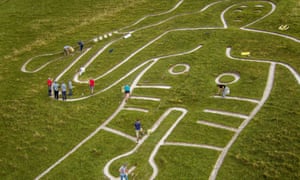hunck
Antediluvian
- Joined
- Jul 13, 2011
- Messages
- 9,489
- Location
- Hobbs End
The changing size of the member:
I think that in some early pictures there is a navel as well as ribs and nipples. It would be fairly easy for a not-that-committed workforce to add the navel into the length of the member and..... Voila!
Wiki agrees:
From a review of historical depictions of the figure, it has been identified that the Giant's current large erection is, in fact, the result of merging a circle representing his navel with a smaller penis during a 1908 re-cut: the navel still appears on a late 1890s picture postcard.
I haven't found any photos which show this, or the postcard.
Road sign at Cerne Abbas





